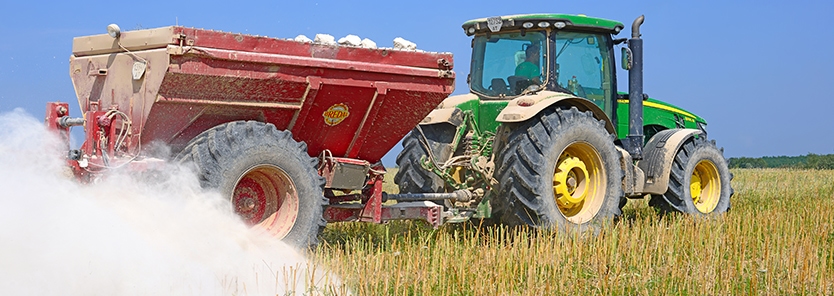Lime for Food Plots – The Basics
For the last 10 to 15 years, people who really didn’t have a background in farming have come to realize the benefits of adding lime to their food plots and other plantings. Thanks to the “keyboard warriors” of “cyber world” and the age of instant information, there is endless amounts of literature you can study on the effectiveness of adding lime to correct a soil’s pH.
In general, lime is commonly needed to reduce the acidity of a soil, allowing whatever crop, tree, or vegetation growing there to more readily uptake nutrients. If someone has been adding fertilizer to their field for years, but has never checked the pH to see if lime was needed, if they had a low pH (acidic soil) they are usually amazed at the difference in plant health and growth after a proper application of lime.
I have worked with numerous hunting clubs/leases that were planting the same blends every year for a decade or more and always applied something like 13-13-13 fertilizer…but never tested the soil.
A simple application of the appropriate amount of lime drastically improves their food plot performance. I have even suggested to numerous people to forgo their fertilizer application for that year and just get the lime incorporated, especially when a budget pressures a gamekeeper to decide between one or the other.
Why lime for food plots is important
To begin, here’s why lime chemically changes your soil pH. Lime is “calcium carbonate” (CaCO3), and low pH soils have excess hydrogen. If you can remove or reduce the hydrogen you raise your soil’s pH, or reduce the acidity. When the hydrogen combines with the lime to form water, (H20), this leaves car-bon dioxide (CO2) which obviously is an essential plant fuel. So by adding lime to a low pH soil you end up with water, calcium, and carbon dioxide, all beneficial to plants.
Decreased water penetration, poor plant health, increased bug and disease issues, and lack of nutrient uptake are just some of the problems created in soils with pH levels below the ideal range. Calcium plays a large part in nitrogen efficiency in plants as well as strengthening cell walls. The large molecule size of calcium also provides some huge benefits in the way of reducing soil compaction which provides more space for root growth and improves water movement in the soil profile.
 |
A liming material’s effectiveness is measured and known as its (ECCE) effective calcium carbonate equivalent. This ECCE is based on the materials purity and how finely its particles are ground at a quarry. As a rule, the more finely ground lime will react with soil quicker than a coarse, or larger size lime particles.
Agricultural lime sources can vary a good bit across the country. The percentage ECCE is important to know for your lime source so you can apply the correct amount.
The Biologic Soil Sample Report not only tells you your current pH level and how much is needed to remedy the problem, it also has an equation to enter in your ECCE so you know exactly how much to apply specific to “your soil.”
Lime for Food Plots – Pelletized lime versus Agricultural lime
No A very popular topic of conversation when applying lime is “pelletized lime versus agricultural lime.” There are a lot of opinions and some “wives’ tales,” if you will, on pelletized lime being more effective and requiring significantly less of it to equal an application of ag lime. The short answer is, that is false. Let me explain why.
The two most popular and readily available forms of lime across the country are dolomitic lime and calcitic lime, and both are used to accomplish the same goal of decreasing soil acidity. Dolomitic lime is derived from deposits of calcium carbonate and magnesium carbonate and thus it contains a high level of magnesium.
Calcitic lime is derived from primarily calcium carbonate. Magnesium is an important mineral for plant health, so if your soil is naturally high in magnesium content but needs a lime application you would need to use the calcitic form to avoid receiving an excess level of soil magnesium. This misconception of pelletized lime being more efficient than ag lime comes from the issue that some pelletized lime has a higher ECCE than a particular area’s ag lime, mostly because it has passed through a finer screen to be converted to a pellet. Also, pelletized lime is thought to react and provide faster results than ag lime. This can be true if you are comparing “calcitic pelletized lime” versus “dolomitic ag lime,” but pelletized and ag lime should be available in both forms.
Most agricultural lime sources range from 65 – 85 % ECCE. So, if your soil test called for one ton of 100% ECCE lime you would need to apply 1.33 tons per acre of a 75% ECCE lime. If a pelletized lime source were 90% ECCE it would take 1.11 tons per acre of this form to do the same job. This is a far cry from the, “It only takes a ¼ of the amount of pelletized lime versus ag lime” statement I have heard more than once. So although there are some instances where a little less pelletized lime is needed than ag lime, it’s a pretty negligible amount especially considering most people spread it in large quantities and it isn’t being figured to the 50lb bag quantities like you would with NPK fertilizer.
 |
Pelletized lime does have a major benefit for the food plot guy in that it is easily spread from most any type spreader and is readily available at wide variety of co-op’s, home improvement stores, and even Wal-Mart. Many areas where food plots get planted are not very accessible to a large spreader used for applying bulk ag lime. If your place does have good enough access for large equipment, ag lime can definitely be easier on the checkbook.
Hopefully that explains lime a little bit for you and how important it can be to growing successful crops. Fertilizer and lime recommendations can be a little confusing. All the different numbers and suggestions can sometimes make it difficult to understand exactly what your soil and crop needs to perform its best.
standards.
3 key tips to remember
1. Soil pH is the first thing you need to get right. Although some crops are more tolerant of acidic soils than others, most food plot crops perform best with a pH of 6.2-7.0. Lime is relatively inexpensive and is really important for successful plots. For perspective, a plot with a pH of 5.5 is 10 times more acidic than one at 6.5! Over 50% of fertilizer added to a plot with a 5.5 pH is wasted because it is not able to be used by the plants. 1 to 2 tons (or sometimes more) of lime per acre is very common to get your plots where they need to be.
 |
2. Remember that the 3 numbers on bagged fertilizer (N-P-K) are based off of 100lbs, not 50. In a 50lb bag of 13-13-13, there are 6.5 lbs or “units” each of actual nitro-gen, phosphorous, and potassium. If your sample says you need 40lbs each of N-P-K, you would need 350lbs per acre of 13-13-13. This would give you 45.5 lbs each of nitrogen, phosphorous, and potassium.
3. An advanced soil test is needed to get current levels of micronutrients like copper, iron, zinc, boron, etc. These micros are usually not present in bagged fertilizer. Although they are needed in very small amounts in comparison to the macro’s (N-P-K), it can be worthwhile to do an advanced sample every 3-4 years and keep the micro’s up to date.
For help understanding your soil samples, email adelano@mossyoak.com
Regardless of the size of the field you are working with, correcting the pH level with lime can do wonders for the growth of plants in less than ideal areas.
~
For more from GameKeeper Farming For Wildlife, join our weekly newsletter or subscribe to GameKeepers Magazine. Your source for information, equipment, know-how, deals and discounts to help you get the most from every hard-earned moment in the field.






